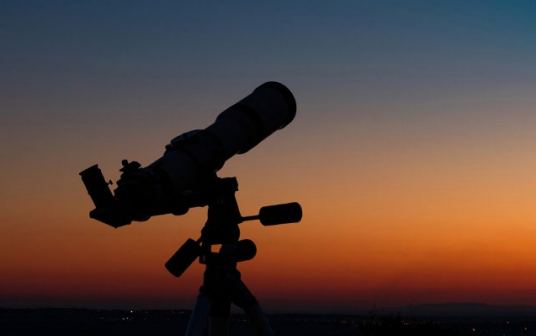Adapted from the writings of Dayan Yitzhak Grossman April 18, 2024 AP News reports: A…

Shooting Stars: May We Photograph Celestial Bodies?
Adapted from the writings of Dayan Yitzhak Grossman
January 12, 2022
NASA’s uncrewed Artemis I Moon-orbiting mission recently sent back some spectacular images of the Moon and the Earth,[1] and the Visible Infrared Imaging Radiometer Suite (VIIRS) instrument on the NOAA-21 satellite produced a stunning composite image of the Earth.[2]
Although the making of such images is certainly permitted for non-Jews, it is prohibited for Jews. The Torah commands: “You shall not make [images of what is] with Me; gods of silver and gods of gold shall you not make for yourselves.”[3] While one might have thought that this pasuk is forbidding the construction of idols, Chazal and the pshat-oriented mefarshim interpret it to forbid fashioning depictions of certain entities, because people may err and ascribe divinity and power to them.[4]
Chazal list a number of entities that are included in this prohibition: Ophanim, Seraphim, Chayos, malachei hashareis, the Sun, the Moon, the stars, the constellations, and humans.[5] While several Ashkenazi Rishonim maintain that the prohibition extends to animals, the consensus of the poskim is that it does not.[6]
In the course of its complex discussion of this prohibition, the Gemara distinguishes between protruding (boleit) images, which are prohibited, and sunken (shokeia) ones, which are permitted. The halacha follows the view of many (though not all) Rishonim that this distinction applies only to images of humans, but not to those of celestial objects. Because humans are “protruding” entities and clearly perceived as such, only protruding representations of them prohibited, but heavenly bodies are “sunken in the firmament,” or at least are so perceived by people, so even sunken representations of them are prohibited.[7] There is an opinion that only protruding or sunken representations are prohibited, but flat ones of ink or paint are permitted, but the halachic consensus is that these are also prohibited.[8]
Since even flat images of celestial bodies are prohibited, some authorities maintain that photographs of them are too.[9] But R’ Shmuel Wosner is unsure about this, “because the image is recorded by itself via the known processes of photography.”[10]
Some maintain that only complete images of celestial bodies are prohibited. Others argue that partial images of the Moon are prohibited, because the partial Moon appears in the sky,[11] but partial images of the Sun are permitted, because the Sun appears in the sky whole (even though it emerges and disappears gradually, so part of its disc is not visible at sunrise and sunset).[12] Others maintain that partial images of the Sun are also prohibited.[13]
This author is aware of only limited discussion of the permissibility of displaying and viewing images of the celestial bodies on electronic screens, which present images without producing a permanent record.[14]
R’ Yitzchak Yaakov Weiss (the Minchas Yitzchak) considers it obvious that with regard to heavenly bodies, “there is no distinction between permanent (miskayemes) and impermanent (eino miskayemes)” images, and he accordingly forbids using a film projector to display an image of the Sun upon a wall. It would seem to follow that displaying an image on a computer screen should be prohibited as well, unless we distinguish between the two on the grounds that in the case of the film projector, the projected image is a manifestation of a real image on the film, while in the case of the computer screen, there is no “real” image at all.
Extending the prohibition to computer screens would obviously be a rather onerous stringency, as one would have to refrain from viewing any image or video containing celestial bodies. Further analysis of this question is required.[15]
[1]Stunning photos from NASA’s Artemis I Moon mission. CBS News. https://www.cbsnews.com/pictures/nasa-Moon-mission-artemis/.
[2]First Image Released from NOAA-21 VIIRS instrument. National Environmental Satellite Data and Information Service (NESDIS).
[3]Shmos 20:20.
[4]Rashbam ibid.; Sefer Hamitzvos lo sa’aseh 4; Ralbag ibid. biur hamilos.
[5]Rosh Hashanah 24b; Avodah Zarah 43b. There is an additional category of prohibited depictions comprising the Sanctuary (heichal), Entrance Hall (ulam), and Courtyard (azarah) of the Bais Hamikdash and its vessels. The contours of this portion of the prohibition are beyond the scope of this article; cf. Halachipedia: Drawing or Sculpting Forbidden Images: Replications of the Vessels of the Temple. For more information and sources on all the various aspects of this prohibition, see the Halachipedia article; R’ Doniel Neustadt, Making An Image Of Celestial Bodies; Halachos of Forbidden Images (Halachically Speaking–YWN).
[6]See Bais Yosef Y.D. siman 141; Shu”t Lechem Rav siman 15. Cf. Halachipedia: Drawing or Sculpting Forbidden Images: Animals and Plants.
[7]See Hilchos Avodah Zarah 3:10-11; Hasagos HaRa’avad ibid.; Ran Avodah Zarah 43b (19a in Rif pagination); Bais Yosef ibid.
[8]See Lechem Rav ibid.; Shu”t Divrei Malkiel cheilek 3 siman 58.
[9]Divrei Malkiel ibid. takes for granted that a photograph is the equivalent of a flat ink or paint image (although he is discussing photographing human beings, not celestial bodies). Shu”t Minchas Yitzchak cheilek 10 siman 72 takes for granted that photography of celestial bodies is prohibited. Chut Shani also forbids photographing the Sun (in its entirety–see below).
[10]Shu”t Sheivet Halevi cheilek 7 siman 134 osios 5, 7. Cf. Halachipedia: Drawing or Sculpting Forbidden Images: Sun, Moon, and Stars.
[11]See Darchei Teshuvah Y.D. siman 141 os 38.
[12]Sheivet Halevi ibid. os 7; Chut Shani.
[13]Mekor Mayim Chayim Y.D. ibid. end of se’if 7 (cited in Darchei Teshuvah ibid. os 51 and Minchas Yitzchak ibid.), and cf. Shu”t Yabia Omer cheilek 10 Y.D. siman 58 Kovetz He’aros Vehe’aros al Shu”t Rav Pe’alim cheilek 4 cheilek Y.D. os 6 p. 478; Halachipedia ibid. nn. 38-40.
[14]In other halachic contexts, there is substantial discussion among recent authorities as to the status of text displayed on computer screens. See, e.g., Shu”t Sheivet Halevi cheilek 7 siman 4 and Daily Halacha 8 Adar, 5782: Erasing Hashem’s Name from Computer Files.
[15]Cf. Halachos of Forbidden Images at n. 33.





